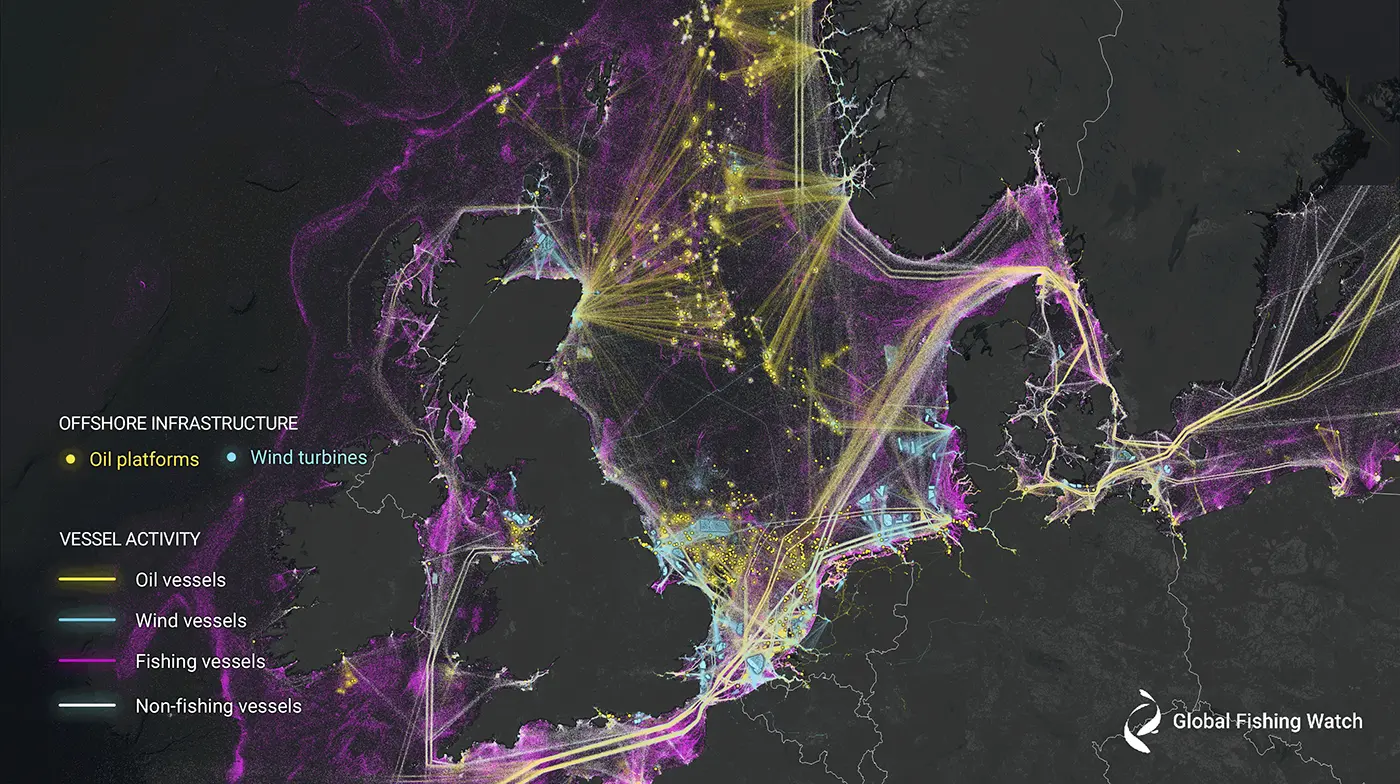An unparalleled perspective on the industrial usage of the ocean and its changing dynamics is provided by a recent study that was published in the journal Nature.
 Global Fishing Watch uses AI and satellite imagery to map vessel traffic and offshore infrastructure to provide an unprecedented view of previously unmapped industrial use of the ocean, as seen here in the North Sea. Image Credit: 2023 Global Fishing Watch
Global Fishing Watch uses AI and satellite imagery to map vessel traffic and offshore infrastructure to provide an unprecedented view of previously unmapped industrial use of the ocean, as seen here in the North Sea. Image Credit: 2023 Global Fishing Watch
The groundbreaking study, headed by Global Fishing Watch, finds a startling amount of activity that was previously “dark” to public monitoring systems. It does this by using machine learning and satellite imagery to produce the first worldwide map of big vessel traffic and offshore infrastructure.
A new industrial revolution has been emerging in our seas undetected—until now. On land, we have detailed maps of almost every road and building on the planet. In contrast, growth in our ocean has been largely hidden from public view. This study helps eliminate the blind spots and shed light on the breadth and intensity of human activity at sea.
David Kroodsma, Study Co-Lead Author and Director, Research and Innovation, Global Fishing Watch
In coastal waters across six continents, where over three-quarters of industrial activity is concentrated, researchers from Global Fishing Watch, the University of Wisconsin-Madison, Duke University, UC Santa Barbara, and SkyTruth analyzed 2 million gigabytes of satellite imagery from 2017 to 2021 to find vessels and offshore infrastructure.
Historically, vessel activity has been poorly documented, limiting our understanding of how the world’s largest public resource—the ocean—is being used. By combining space technology with state-of-the-art machine learning, we mapped undisclosed industrial activity at sea on a scale never done before.
Fernando Paolo, Study Co-Lead Author and Senior Machine Learning Engineer, Global Fishing Watch
While not all boats are legally compelled to broadcast their location, vessels that are not monitored by public networks, known as “dark fleets,” offer significant issues for safeguarding and managing natural resources.
Researchers discovered a large number of dark fishing vessels inside various marine protected zones, as well as a significant concentration of vessels in many countries’ oceans that had previously shown no vessel activity by public monitoring systems.
Publicly available data wrongly suggests that Asia and Europe have similar amounts of fishing within their borders, but our mapping reveals that Asia dominates—for every 10 fishing vessels we found on the water, seven were in Asia while only one was in Europe. By revealing dark vessels, we have created the most comprehensive public picture of global industrial fishing available.
Jennifer Raynor, Study Co-Author and Professor, Natural Resource Economics, University of Wisconsin-Madison
The study also demonstrates the changing nature of human activities in the ocean. Fishing activity decreased globally by around 12 percent during the COVID-19 pandemic, falling by 8 percent in China and 14 percent in other countries. Transport and energy vessel activity, however, continued to be steady.
During the research period, offshore energy development grew significantly. Wind turbines more than doubled, while oil structures grew by sixteen percent. Turbines surpassed oil platforms in number by 2021. The most notable expansion occurred in China’s offshore wind energy, which increased ninefold between 2017 and 2021.
Study co-author Patrick Halpin, who is a Professor of Marine Geospatial Ecology at Duke University, added, “The footprint of the Anthropocene is no longer limited to terra firma. Having a more complete view of ocean industrialization allows us to see new growth in offshore wind, aquaculture and mining that is rapidly being added to established industrial fishing, shipping and oil and gas activities. Our work reveals that the global ocean is a busy, crowded and complex industrial workspace of the growing blue economy.”
The study emphasizes how this new technology could be used to combat climate change. While infrastructure maps can help in tracking marine deterioration brought on by oil exploration or provide guidance for wind development, mapping all vessel movement will enhance estimates of greenhouse gas emissions at sea.
“Identifying offshore infrastructure is critical for understanding offshore energy development impacts and trends, and is crucial data for our work to detect marine pollution events and hold responsible parties to account,” stated co-author Christian Thomas, a geospatial engineer at SkyTruth.
Governments, academics, and civil society can find areas of potentially illicit activity, locate industrial fishing vessels encroaching on artisanal fishing grounds, or just gain a better understanding of vessel traffic in their waters with the use of open data and technology employed in this study.
Kroodsma added, “Previously, this type of satellite monitoring was only available to those who could pay for it. Now it is freely available to all nations. This study marks the beginning of a new era in ocean management and transparency.”
The study was made possible thanks to the support of Bloomberg Philanthropies, National Geographic Pristine Seas and Oceankind, and their technology partner, Google. As a recipient of The Audacious Project, a collaborative financing effort that is driving large-scale social change, Global Fishing Watch is able to expand the implementation of this groundbreaking work.
Journal Reference:
Paolo, F., et. al. (2023) Satellite mapping reveals extensive industrial activity at sea. Nature. doi:10.1038/s41586-023-06825-8.